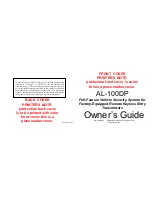
As per UL 521 Section 55.2, in order to minimize the possibility of false alarms, detectors shall not be mounted in a location where the thermal air path
to it may be obstructed. For additional information, consult the Fenwal Automatic Fire Detection Application Engineering Manual MC-402, NFPA-72
and the local AHJ.
Mounting
Bases are mounted directly on the electrical junction boxes (3, 3.5, and 4 inch octagonal; 3 inch round; 4 inch square) without any type of mechanical
adapter.
SMOKE DETECTORS - DUCT APPLICATIONS
General
The NFPA states that Duct Smoke Detectors must not be used as a substitute for open area protection. Duct detection is intended for use in the
control of air handling equipment for the purpose of closing dampers or shutting down of air handling units. A Model RA 914 Remote Test Station must
be used in conjunction with all detectors used in ducts. This limits the types of bases that may be used to the 2WRLT, 2WRB and 4WRB. See Figures
2 through 5 for wiring details.
Pre-installation Rules
Fenwal recommends actual measurements of the air flows and examination of engineering specifications that define expected velocities in all models
of equipment used to determine if a location is suitable for air duct detection operation. An Alnor Instrument Co., Chicago, IL Model 6000P Velometer,
or equivalent may be used to check the duct air velocity.
Air Velocities
Velocity Ratings of Detectors when used for In-Duct applications are as follows:
Model
In-Duct (fpm)
Model
In-Duct (fpm)
CPD-7051
500 - 2000
PSD-7155P
500 - 4000
CPD-7051D
500 - 2000
PSD-7155D
500 - 4000
Installation Rules
1.
Refer to NFPA 72 Appendix-A for detector installation requirements.
2.Locate Detectors approximately 6-duct widths downstream from bends or inlets.
These locations are fairly uniform in non-turbulent airflow and
homogenous with respect to air/smoke mixing.
Exception
: Where it is physically impossible to locate the detector accordingly, the detector can be positioned closer than 6-duct
widths, but as far as possible from the opening, bend or deflection plates.
3
.
Locate duct detectors so that dampers do not restrict air flow at the detector location.
4.Locate air duct detectors on the return duct of the equipments air handling system.
However, detectors should not be installed in the return air
damper branch.
5.Locate detectors on branch lines if close identification of the source of alarm is required.
6.Locate detectors on the downstream side of filters to sense fires in the filters.
However, it should be noted that should the filters block the air
flow, sufficient air flow may no longer be present for proper operation of the duct detector.
7.Locate detectors, whenever possible, where they can be conveniently observed and readily serviced.
8.Locate detectors in return air ducts ahead of mixing areas.
9.Do not locate detectors immediately following outside air inlets except to monitor smoke entry to the handling system from an adjacent area.
10.When possible, locate detectors upstream of air humidifiers and downstream of dehumidifiers.
INSTALLATION AND WIRING NOTES AND CAUTIONS
1.To ensure proper installation of the detector head to the base, be sure wires are properly dressed at installation.
Position all wires flat against the
base. Take all slack in the outlet box. Route wires away from connector terminals.
2.If the supplied jumper wire has been installed between terminals 6 and 7 (by inserting the jumper into the holes provided in the contact blades of
terminals 6 and 7) to test detector loop continuity, be sure to remove the jumper before installing the detector head.
3.Do not loop wire under Terminal 1.
Break wire run to provide supervision of connections.
4.Observe detector polarity when using LED return wire and when using Remote Test option.
5.All relays are shown in normal position (POWER ON).
Ratings of Auxiliary contacts are as specified in DETECTOR BASES.
6.The end-of-line supervisory device shall be compatible with the control unit used.
The end-of-line supervisory relay utilized shall be and rated for
the DC supply voltage used. The Fenwal end of line relay P/N 29-116788-001 is rated for 24 VDC operation.
7.When detectors employ the 2WRB base with relay, all detectors on a loop must be equipped with this option and all must be interconnected to
perform a common function.
8.Model RA-911 P/N 70-200000-911 Remote LEDs can be installed with both Smoke (CPD & PSD) and Heat (THD) Detectors.
9.Model RA-914 P/N 70-200000-914 Remote Test Switches can be installed only with Smoke (CPD & PSD) Detectors.
10.Do not install detector heads until the area has been thoroughly cleaned of construction debris, dust, etc.
11. As per UL 268 Section 77.1.7, Smoke Detectors are not to be installed with detector guards unless the combination has been evaluated and
found suitable for that purpose.
WIRING DIAGRAMS
Figures 1, 2, 3 and 4 are typical wiring diagrams of 2-Wire Detector systems and Figure 5 shows a 4-Wire detector system (field wiring is shown
dashed).



























